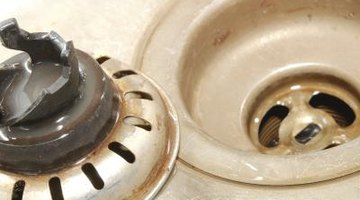What Is the Minimum Drain Line Size for a Kitchen Sink?
Kitchen sinks have standard drain line sizes, which means all sinks manufactured adhere to the same basic dimensions as far as the drain is concerned. Sinks are a common appliance, and therefore standardizing the most common features for better functionality and interchangeability just makes sense.
Kitchen Sink Drain Sizes

All kitchen sinks today have the same diameter drain, which is 3 1/2 inches and is larger than a bathroom drain which measures in at 1 1/4 inches. It is the same size as a typical standard shower drain, however. When installing a new drain into the sink, you have no need to shop for certain diameter drains. All drains manufactured will adhere to this standard size. The drain size is not random; it is sized to meet certain needs. The drain line is also sized for functional reasons.
Kitchen Drain Line Sizes
The drain line running to your kitchen sink is also sized to accommodate the water flow from your sink; however, it is not standardized. It must drain off the water dispensed from your faucet and handle the waste that is sent down the drain. So the drain line is usually 1 1/2 inches in diameter. This size drain line is sufficient for kitchen use. A bathroom sink drain line is typically 1 1/4 inches, slightly smaller. Some kitchen sinks experiencing very light use may use this size drain, but it is not recommended. It is the absolute minimum drain line size for any kitchen faucet. Any smaller and the drain line will clog frequently.
Drain Line Setup
Most kitchen sinks have a P-trap drain line, which is an S-shaped piping joint installed right below the sink. The shape of the drain prevents back flow into the sink because the water travels up the side of the P-trap before flowing straight down through the drain, which is common in any sink drain system. Bathroom and bar sinks also use this configuration to reduce back flow. The P-trap is then routed to the drainpipe, which is usually a horizontal pipe routed from the home's drain line to under the sink.
Plumbing a Drain
When plumbing a drain, the 1 1/4-inch drain line is run to the P-trap and then to the main drain line. If the main drain line is larger, a step down adapter is installed. Main drain lines are designed to handle larger loads and are sized appropriately. Some drain lines run between 1 1/2 to 2 inches in diameter. Each time a pipe is connected to a larger diameter pipe, an adapter is used to bridge the connection.
Resources
Writer Bio
Steve Smith has published articles on a wide range of topics including cars, travel, lifestyle, business, golf, weddings and careers. His articles, features and news stories have appeared in newspapers, consumer magazines and on various websites. Smith holds a Bachelor of Arts in English and journalism from University of New Hampshire Durham.
Photo Credits
- Hemera Technologies/AbleStock.com/Getty Images
More Articles
- What Are the Pros & Cons of a Sink With an Off-Center Drain Vs. a Center Drain?
- Drain Trap Sizes for Bathtubs
- Smallest Reasonable Dimensions for a Full Bathroom
- How to Install Drain Pipes for a Septic Tank Yourself
- Pea Gravel vs. Stone for a French Drain
- Can I Install a Dishwasher Without a Sink in an Island?



